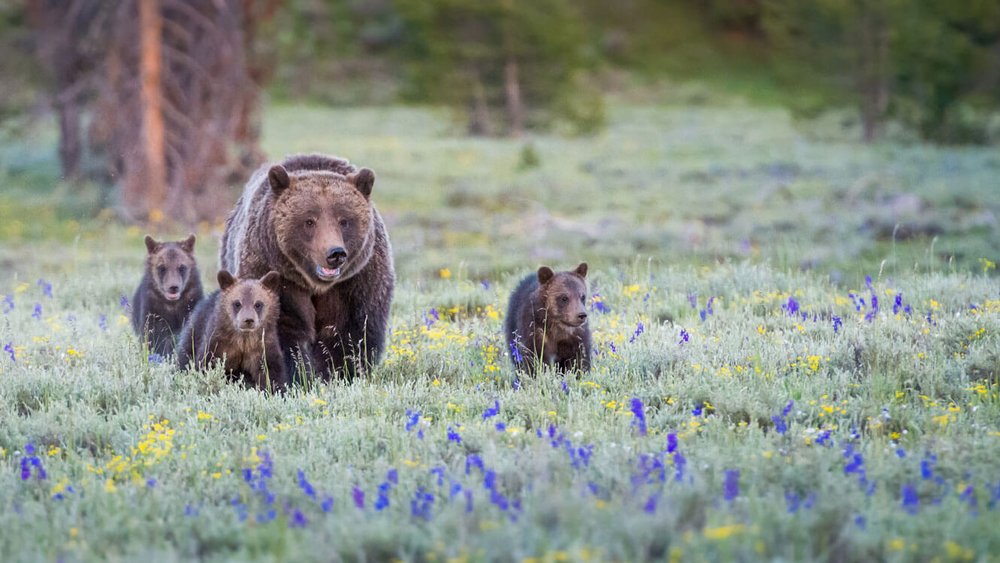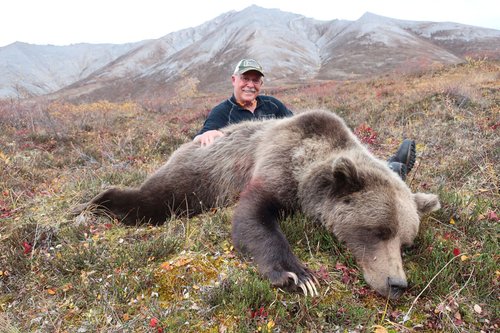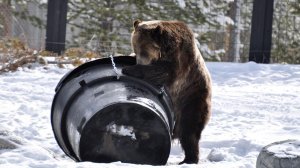Fish and Wildlife Service Weighing Whether to Drop Federal Protections for Grizzly Bears
On February 6th, the U.S. Fish and Wildlife Service (USFWS) announced it will review whether to delist grizzly bears from the Endangered Species Act in the Northern Continental Divide Ecosystem – which includes the Badger-Two Medicine, Glacier National Park, Bob Marshall Wilderness Complex and adjacent lands – and in the Greater Yellowstone Ecosystem. The announcement came in response from two petitions filed by the states of Montana and Wyoming that argued these two grizzly bear populations have met federal recovery criteria and that primary management for these populations should be transferred to the states.
This announcement kicks off a 12-month status review process during which the public is strongly encouraged to provide the USFWS with information the agency should consider when making its decision. Undertaking a status review does not mean the agency will, nor that it should, conclude either population should be de-listed. During the review, the USFWS will pay particular attention to any new information that has surfaced since the last status review conducted in 2021. That review, a routine 5-year review required by the ESA, concluded that grizzly bears should remain listed as a threatened species, in large part due to limited population sizes, and their continued isolation from one another.

More information & to submit comments:
More information about the Status Review is available here.
Comments or new scientific or commercial information the USFWS should consider can be submitted one of the two following ways:
Electronically:
Comments can be submitted at Regulations.gov. Click on the blue “Comment” button. Attachments should be in MS Word.
US Mail:
Public Comments Processing,
Attn: FWS-R6-ES-2022-0150,
U.S. Fish and Wildlife Service,
MS: PRB/3W, 5275 Leesburg Pike,
Falls Church, VA 22041–3803.
Why This Matters
Grizzly bears, which historically ranged in the tens of thousands throughout the northern Rockies and the West, including all of Montana, were largely extirpated after colonization. By 1975, when grizzly bears were listed as a threatened species, only small populations survived in isolated, mountainous parts of Montana, Idaho, Wyoming, Washington, and Colorado. Current estimates for the Northern Continental Divide Ecosystem population – the largest and most secure of the four remaining grizzly bear populations – suggest approximately 1,100 bears in the region. While this is up significantly from an estimated population of 300 in 1986, population growth has been fairly stagnant for the past decade even as bears have expanded their range, according to biological data from the USFWS and state of Montana.
The Status Review comes at a particularly fraught time for grizzly bear recovery. Despite progress in recent decades, most, if not all, grizzly bear populations still have not met scientific and legal criteria for delisting. The bears future in our region is far from secure, due to mounting pressures from explosive development in western Montana, increased recreational use of public lands, transportation infrastructure and climate change, to name a few. Grizzly bears have also come under increasing attack from mostly Republican politicians who want to see wildlife managers take a more lethal, rather than scientific and precautionary, approach to managing these animals. Montana, Wyoming, and Idaho have vowed to institute trophy hunts for grizzly bears as soon as federal protections are lifted. To this end, Gov. Gianforte has made delisting a priority of his administration. Sen. Steve Daines and Rep. Ryan Zinke have introduced companion legislation in Congress to strip ESA protections from grizzly bears.
Our Top Concerns
Glacier-Two Medicine Alliance is still formulating our detailed response and recommended comments to the USFWS. These are the four primary concerns we will focus on.
- The lack of regulatory mechanisms to ensure Montana will manage for healthy, robust grizzly bear populations after federal protections are lifted.

Montana, as well as Wyoming and Idaho, have proposed to establish limited-draw grizzly bear hunts if the bears are delisted. Grizzly bear hunting is currently legal only in Alaska (pictured above) and the northern territories of Canada, as both British Columbia and Alberta have phased out the practice. (Photo: Bill Molly’s Adventures) The existence of adequate regulatory mechanisms to ensure a state can maintain viable populations of a recovered species is a cardinal test of whether the species can be delisted. Sadly, over the past few years, the Montana legislature, like the legislatures in Wyoming and Idaho, have weakened their regulatory mechanisms and undermined their science-based wildlife management for species like grizzly bears. In 2021, for example, the Montana legislature passed laws to require state wildlife managers allow the public to snare wolves, hunt black bears with hounds, and kill any grizzly bear they judge to “threaten” a person or livestock, whatever that means. More of the same is underway this session. Notably, the status review announcement said these and other laws will receive careful scrutiny in their decision. Another concern about the willingness of the state to maintain a robust grizzly bear population is the draft statewide plan’s suggestion of reducing the current grizzly bear population through increased management euthanasia or trophy hunting. Finally, we’ll also be reviewing what federal regulations, such as minimum road density standards or food storage orders, that have helped bears recover may be loosened should bears lose federal protections.
- Scientific concerns about recent population estimates and trends as well as the state of Montana’s methodology for monitoring grizzly bear populations.
Recovering and sustaining grizzly bear populations requires accurate estimates of their size and trends in order to manage mortality to prevent an unforeseen and inexorable decline in the population. While recent population estimates suggest a stable population in the NCDE, there is declining statistical confidence in the accuracy of these estimates. There are also concerns the methodology Montana relies on to monitor for mortality and estimate the population may significantly undercount the number of bears, which could lead to more bears being euthanized by managers or tags issued to hunters in the future than the population can support. - The lack of natural genetic and demographic connectivity between grizzly bear populations
The long-term persistence of grizzly bears in the northern Rockies depends in large part on the ability of individual bears to move between populations to breed and raise young. Yet despite remarkable range expansion in recent decades, no grizzly bears are known to have yet naturally migrated between populations, leaving them genetically isolated, and in the case of the Cabinet-Yaak, barely hanging on. Unfortunately, the state of Montana’s recent draft management plan, which would guide management if bears are delisted, would make establishing and maintaining connectivity unlikely. Amongst other flaws, the plan fails to require the state to manage for grizzly bear presence, improve habitat security, or prioritize conflict prevention in connectivity areas. Instead, it proposes liberal standards for euthanizing bears involved in conflicts, removal of conflict-free bears in certain circumstances, and trophy hunting. - The pressures grizzly bears face from increasing human development, roads, and recreation, as well as from climate change.
Accelerating land use development in western Montana is eliminating grizzly bear habitat as well as impacting the ability of bears to move across the landscape. It’s also leading to increased traffic, such as on US Highway 2, which presents a substantial barrier to bear movement as well as a growing source of mortality. Additionally, changing recreational use levels and patterns are leading to more conflicts between recreationists and bears, including displacement from desired habitat or habituation. At the same time, climate change is impacting important food sources such as whitebark pine seeds and berry crops, forcing bears to seek food in human-dominated landscapes, like apples or chickens like bears did in unprecedented fashion last year when the berry crop failed, which leads inevitably to more conflicts and more dead bears.
Final Thoughts

Grizzly bears in the NCDE and GYE have made a remarkable comeback thanks to the Endangered Species Act, yet they still have a ways to go to achieve a biologically sustainable recovery. Furthering these incipient gains is far from certain however, especially without continued federal protection.
No matter what recommendation the USFWS ultimately makes regarding the bears’ status, ensuring a healthy, resilient grizzly bear population in the NCDE and elsewhere in Montana will require continued protection of key habitats and habitat security, limiting human-caused sources of mortality, and facilitating movement between populations. Equally important will be strong partnerships and investments that further access to knowledge, practices and technology that help people, including farmers and ranchers, rural residents, and recreationalists, successfully share the landscape with grizzly bears. For years, Glacier-Two Medicine Alliance has worked to advance the great bear’s recovery by protecting habitat, promoting connectivity, and providing educational information about safely living and recreating in bear country. As the status review moves forward, we are committed to continuing to do our part to secure a vibrant future for grizzly bears and human communities throughout our mission area.
More Information or To Submit Comments
More information about the Status Review is available here.
Comments or new scientific or commercial information the USFWS should consider can be submitted one of the two following ways:
Electronically:
Comments can be submitted at Regulations.gov. Click on the blue “Comment” button. Attachments should be in MS Word.
US Mail:
Public Comments Processing,
Attn: FWS-R6-ES-2022-0150,
U.S. Fish and Wildlife Service,
MS: PRB/3W, 5275 Leesburg Pike,
Falls Church, VA 22041–3803.
